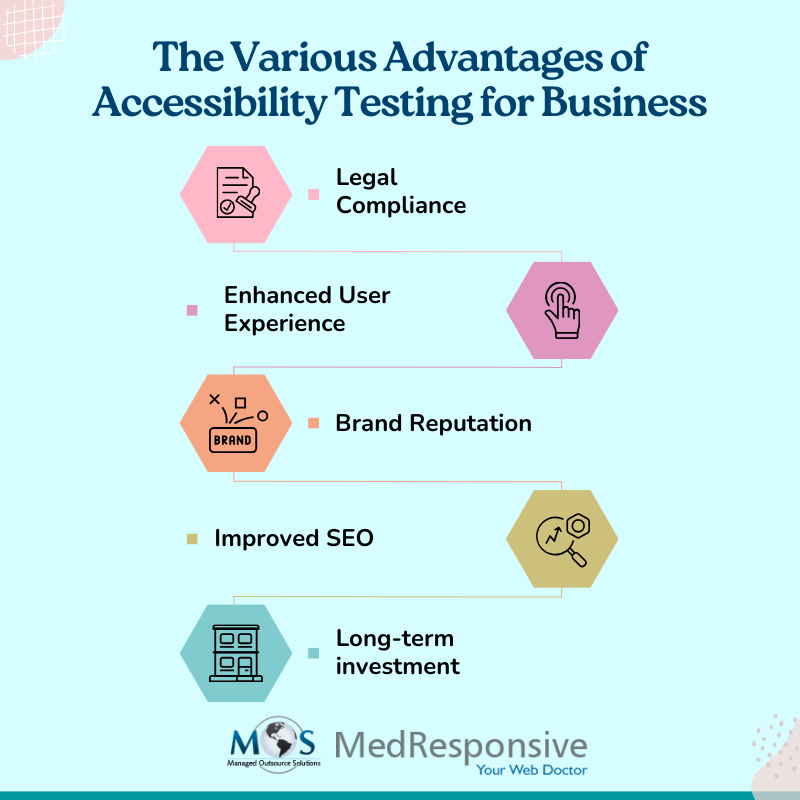What Is Accessibility Testing?
Accessibility testing is an aspect of software development focused on the process of evaluating digital content such as a website to ensure usability without relying on traditional means of interaction. The goal of accessibility testing is to make sure websites, web applications, and other digital products are accessible for everyone, including users with disabilities. During the accessibility testing process, digital components are tested for accessibility of various types of disabilities, such as:
- Visual
- Auditory
- Cognitive
- Neurological
- Mobility-related
Accessibility testing facilitates an inclusive digital user experience that is not only ethical, but also profitable, as the CDC reported that 1 in 4 Americans, that is, over 70 million adults, live with some type of disability. However, businesses often fall short in keeping up with the accessibility criteria, as 95.9% of web homepages met with WCAG2 failures. Businesses can mitigate these risks and ensure accessibility for their websites by utilizing website development services.
The Principle of Accessibility Testing
The main principles that govern accessibility testing standards are based on Web Content Accessibility Guidelines, developed by the World Wide Web Consortium (W3C). The set of international standards foundational for website accessibility compliance is as follows:
- Perceivable – The information and user interface (UI) must be presented in a way that is completely perceivable to all users by optimizing features such as the minimum color contrast ratio between text and background, adding captions for videos or providing alternative text for images.
- Operable – The user interactive elements such as links, buttons, and navigation of the digital content, must be operable by all users with the aid of alternate options such as keyboard, voice command, or eye trackers, rather than a mouse.
- Understandable – The entire content and instructions presented on a website must be understandable with clear and concise language to all users.
- Robust – The website must be compatible with a variety of assistive technologies such as screen readers, Braille displays, and voice recognition for content to be interpreted accurately for all users.
Why Is Accessibility Testing Important?
Gone are the days when accessibility testing was considered an expensive afterthought of the web development process. Instead, integrating accessibility testing during the early stages of the web development process is imperative to remain inclusive and comply with the accessibility regulations. Let’s explore the reasons as to why accessibility testing is a top priority for modern businesses:
Legal Compliance
Governmental bodies have increasingly adopted laws and regulations regarding web accessibility to protect people with disabilities against user discrimination and unfair practices. These regulations include the Americans with with Disabilities Act (ADA) that prohibits businesses that are open to the public from discriminating against individuals with disabilities and provide full accommodation of their services. Under this act, businesses such as banks, hospitals, theaters and auditoriums need to ensure website accessibility for people with disabilities. Failure to comply with accessibility laws may lead to legal ramifications for organizations such as fines, penalties or lawsuits. As customers are more conscious of their rights to fair and inclusive business practices, accessibility testing ensures compliance with the current and future legal standards.
Enhanced User Experience
Ensuring accessibility isn’t just for legal compliance and revenue benefits for businesses. It also furnishes an overall enhanced user experience by being inclusive of users with special needs. When your website is compatible with applications such as screen readers, keyboard-only navigation and voice detection, it improves the experience for all users. Accessibility testing ensures that a wider spectrum of audience, regardless of their abilities, can easily access information from your website. This enhances the overall user experience of your business for better customer satisfaction.
Brand Reputation
When your business demonstrates an inclusive and faithful fair practice for accessibility in your service, it adds a layer of authenticity to your brand image. Dedication to ethical and moral practices is a great reputational characteristic for your business as it showcases social commitment and responsibility to customers. This broadens your audience reach to help attract a diverse customer base, encouraging company growth. As awareness around inclusivity grows, consumers are more likely to support brands that demonstrate a commitment to accessibility. This not only fosters brand loyalty but also opens doors to new market segments for your business.
Improved SEO
While Google doesn’t directly consider accessibility criteria for ranking purposes, they do value user experience. Through web accessibility enhancements such as video captions, alternative text and mobile-friendly site design, site owners can provide superior user experience. A website that is easy to navigate leads to increased website dwell time, reduced bounce rates, and higher traffic, positively influencing search rankings By implementing accessibility standards, businesses create clearer content structures and utilize proper HTML tags, making it simpler for search engines to crawl and index their pages. Integrating accessibility testing into digital strategies can enhance SEO performance with improved traffic, reduced bounce rates and achieve higher ranking in search results.
Long-term Investment
Accessibility testing is not a trend, but rather a long-term investment for businesses looking for customer loyalty and enduring company success. By integrating accessibility into your digital service, you can foster customer satisfaction and an inclusive online environment for your business. This proactive approach can result in higher user engagement and conversion rate, ultimately boosting revenue for your business.
Types of Accessibility Testing
- Automated testing – Site owners can employ numerous automated tools to examine and identify any potential accessibility issues with the website such as the level of conformance with W3C accessibility standards.
- Manual testing – Although automated tests are efficient to flag common accessibility issues, it is insufficient as automation may not catch every error since it lacks human observation. It is beneficial to have a hybrid approach by conducting a manual test with the help of automation to save on time and resources.
- User experience review – UX review is detailed outsider analysis of the product’s design to detect any accessibility issues that users may encounter and the overall user experience. The elements analyzed during UX review include aspects such as navigational structure, menu functionality, and information architecture.
- User Testing – User testing goes a step beyond to involve individuals with disabilities during the testing process to assess and provide feedback to confirm the performance of the site in the real world.
Incorporating accessibility testing into the business software development process is not an one-time effort but an ongoing commitment. This process involves evaluating digital content against established standards, such as the Web Content Accessibility Guidelines (WCAG) to comply with the accessibility guidelines. Companies that prioritize accessibility can create a more user-friendly experience, ultimately driving higher user satisfaction, customer retention rates and profitable business growth. Businesses can opt for the services of a software development outsourcing company to achieve the desired financial and operational outcomes.





